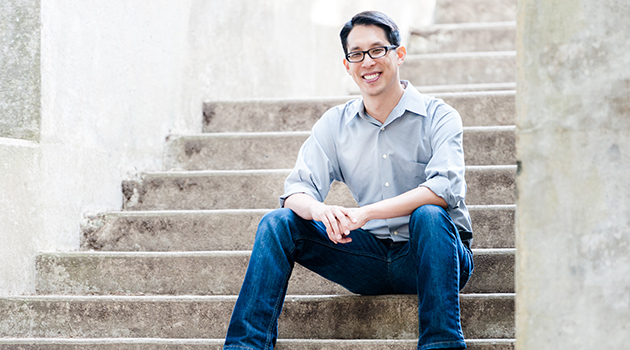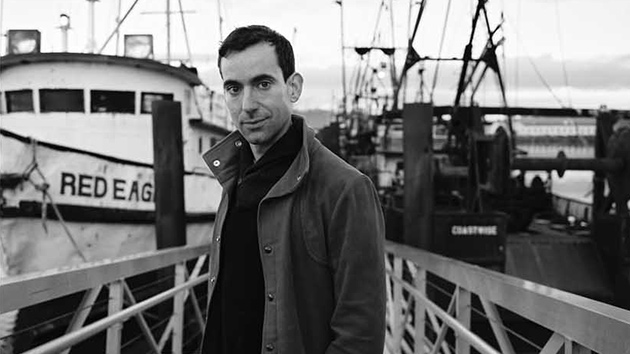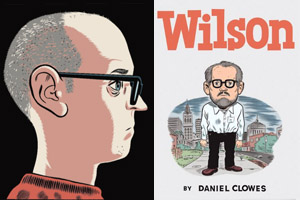
Courtesy Gene Luen Yang
One sunny morning after the kids had split for the summer, I sat down with Gene Luen Yang in an iMac-filled classroom at Bishop O’Dowd High School in Oakland, California, where he was training his replacement after 17 years as a computer science teacher. I was kind of surprised he had a day job. In 2006, Yang’s American Born Chinese became the first graphic novel ever named a National Book Award finalist—it also won an Eisner (the Oscar of comics) and the prestigious Michael L. Printz Award, bestowed by the American Library Association on the best book for teens “based entirely on literary merit.”

He repeated the feat in 2013 after landing on the bestseller lists for a matched pair called Boxers & Saints—character-driven takes on the Boxer Rebellion from opposing perspectives. Yang kept teaching, he told me, because (a) he likes kids—and has four of his own to support, and (b) “I was really worried that sitting at home by myself in front of a computer was going to make me crazy.” Among his other notable extracurriculars are Prime Baby (a hilarious serial comic for the New York Times Magazine) and 2014’s The Shadow Hero, wherein Yang and illustrator Sonny Liew revive the Green Turtle, a 1940s character they believe may have been the first Asian American superhero. Yang also writes the Avatar: The Last Airbender comic book series and recently signed with DC Comics to author the new iteration of Superman.
The latter, as it happens, was Yang’s first comic book—purchased by his mom when he was in fifth grade. (“It was a trustworthy brand,” he explains.) Who’d have guessed that the Man of Steel’s fate would one day lie in the hands of a son of Chinese immigrants? Certainly not Yang, who (like his protagonist in American Born Chinese) struggled with his ethnicity after moving to a white suburb going into first grade. He endured teasing in elementary school, and later at his middle school, where a gang of kids (“the stoners”) would yell racist taunts in the hallways. “I began to wonder if this group was voicing things that everybody thought, but they were the only ones brave enough to say it,” Yang told me. “That’s when I started to feel uncomfortable hanging out with non-Asian friends.”
He also had a growing awareness of being part of a group that was all but invisible in American pop culture. Whenever an Asian actor came on TV, the Yang children would call in their parents to bear witness. Yang had a particular admiration for the X-Men character Jubilation Lee (a.k.a. Jubilee), who was not only Chinese American but confidently so—plus she was “best buddies with Wolverine and she could shoot fireworks out of her hands,” he says.

Back in fifth grade, meanwhile, Yang and a pal had started brainstorming their own superhero stories. “I would do the pencils, he would do the inks, his mom would Xerox them, and we’d sell them at school.” Their creation was Spade Hunter, a Robin Hood knockoff who wielded a discus instead of a bow and arrow. “Every superhero has a symbol, and we thought the spade would be a cool one,” he explains, laughing at his cluelessness. “Later, I was informed by one of my African American friends that Spade Hunter could have racial implications.”
That same year, he took a course in Logo, a coding language designed for the classroom. Using simple commands and programs, a kid could make a little turtle on the screen draw intricate designs. “I just found that amazingly powerful,” Yang says. “That feeling propelled me all the way through getting a degree in computer science and even working in software engineering.”
Art school was his first choice, but his parents weren’t on board, so Yang pursued computer science at UC-Berkeley, with a minor in creative writing. For two years after college, he wrote code for a company called VideoSoft. “It was fun,” he recalls. “We had a pinball machine, a fridge full of Coke—that kind of place. But I was pretty heavily involved in youth ministry at my church growing up, and working with teenagers always seemed really satisfying. Eventually I just couldn’t imagine myself being in a cubicle for my entire career.”

Yang’s dad, a practical-minded electrical engineer, wasn’t too happy about the change. “In my first years teaching, I used to get these envelopes from him with newspaper clippings—want ads from like Google or Apple, software companies, and articles comparing salaries for different professions,” Yang says.
Tiger Dad can rest easy. His son’s books are now the subject of scholarly articles and a staple in high school English and history classrooms. And Yang’s latest project, Secret Coders, combines all three of his careers. In this serial collaboration with illustrator Mike Holmes, which launches September 29, a girl arrives at a mysterious school and promptly alienates everybody before making a friend who helps her unravel the secrets of the place. The plot (which my 10-year-old declared “awesome”) is a clever ploy to impart coding fundamentals, as inspired by that long-ago Logo class. Hey, once a teacher, always a teacher.
Keep reading for our Q&A with Gene Luen Yang.

And now for that chat…
Mother Jones: Why’d you wait so long to quit your day job?
Gene Luen Yang: I liked interacting with students. I liked having coworkers. For a long time, I was really worried that sitting at home by myself in front of a computer was going to make me crazy.
MJ: But you could have subsisted on your comics, right? I mean, you’re a two-time National Book Award finalist!
GLY: Yeah, but I also live in the Bay Area and we have four kids. My wife hasn’t worked for a few years because our kids are little. If she got a job, if we sold two kids, if we moved out of the Bay Area, maybe I could have made it work.
MJ: What inspired Secret Coders?
GLY: I grew up with an Apple 2E—I had a deep, emotional attachment to that machine—and I loved doodling. I took a Logo programming class in fifth grade. Logo is a language specifically designed for the classroom environment. It was basically doodling through words. You type in these commands, and there’s this little turtle on the screen, and as it follows your commands it draws these intricate designs. I just found that amazingly powerful. That feeling propelled me all the way through getting a degree in computer science and even working in software engineering. And eventually becoming a teacher.
MJ: Why did you quit coding to teach?
GLY: I worked at a company called VideoSoft for two years right out of college. It was fun. I had friends, we had a pinball machine, a fridge full of Coke—that kind of place. But I was pretty heavily involved in youth ministry at my church growing up, and working with teenagers always seemed really satisfying. Eventually I just couldn’t imagine myself being in a cubicle for my entire career, so I applied to Bishop O’Dowd. I thought I would just do it for a couple years. I ended up doing it for 17.

MJ: You ditched a lucrative profession.
GLY: Yeah, my dad was not super happy. My mom wanted to become a teacher, too, when she first got to the States, so she understood those impulses in me. My dad is much more practical-minded. In my early years of teaching, I used to get these envelopes from him with newspaper clippings—want ads from like, Google or Apple, software companies, and articles comparing salaries for different professions.
MJ: In American-Born Chinese, your character Jin Wang struggles with Asian stereotypes and his own identity after his family moves from Chinatown to a white suburb. What was your experience as a child of immigrants?
GLY: Even though that book was fiction, I did pull a lot from my own life. I grew up in a predominantly white suburb, Saratoga. That same neighborhood now is like 60 or 70 percent Asian, but when we first moved in, there were just a handful of Chinese Americans at my school. My mom somehow got a list of where all the other Chinese families lived.
MJ: They give that out?
GLY: [Laughs.] Yeah, I think she just went to the school and asked, and we ended up making house calls. Because there were so few of us, that was seen as a natural thing to do. A lot of the angsty stuff in the book comes out of late elementary and junior high. The harsher things that were said to Jin Wang and his friends were things I heard in the hallway.
MJ: Tell me more.
GLY: There was this group of boys known as “the stoners,” and I was hanging out with a small group of Asian American boys. Whenever we passed in the halls, they would always yell something. In my own junior-high insecurities, I began to wonder if this group was voicing things that everybody thought, but they were the only ones brave enough to say it. That’s when I started to feel uncomfortable hanging out with non-Asian friends.
MJ: You were uncomfortable with your ethnicity?
GLY: Yeah, absolutely. I think a lot of us go through a period where we feel like outsiders, and deal with that by wishing we were insiders. So that was the emotional core of American Born Chinese.
MJ: Do you recall the moment when you started feeling this way?
GY: It was a gradual awareness. I remember when my brother and I were watching TV and we’d see a Chinese person come up on American television, it was like an event, something that we would call our parents over to look at. I don’t know how conscious of this I was when I was really little, but eventually, going into college and having a chance to think through these issues a little more deeply, I felt like I was able to finally name this discomfort that I’ve had since I was a kid.
MJ: American Born Chinese has been the subject of at least four scholarly articles. Are teachers assigning your books?
GLY: Yes, especially that one, but Boxers and Saints as well. In the ’40s and ’50s, a lot of teachers and librarians saw the graphic novel as the enemy of reading. But I think reading has got so many more enemies now that graphic novels have kind of flipped over to that side.
MJ: I first read H.G. Wells in graphic form and then read the prose versions later.
GLY: Yeah. They’ve done these studies that have found the average comic-book reader actually reads I think six times as many prose books as the average American. Building a habit of reading leads to all sorts of reading.
MJ: So, Superman! That’s iconic. Wasn’t that the first comic you collected?
GLY: [Laughs.] I actually wanted this other comic, but my mom bought me Superman instead—it’s a trustworthy brand.
MJ: But could you ever have imagined yourself writing it?
GLY: No, it’s absolutely amazing. The artist, John Romita Jr., made his name doing X-Men in the ’80s and ’90s. He doesn’t like it when people say this, but he really is a legend. In high school, I used to line up to get his autograph. Now I get to work with him!
MJ: How did you start out drawing comics?
GLY: In fifth grade I had a friend who was also really into comics, so we would brainstorm stories together. I would do the pencils, he would do the inks, his mom would Xerox them, and we’d sell them at school.
MJ: How entrepreneurial of you. What were they about?
GLY: The main character’s name was Spade Hunter and he was kind of a Robin Hood knockoff. He wore all green, but instead of a bow and arrow he had this discus he would throw at people’s heads.
MJ: Spade Hunter?
GLY: Every superhero has a symbol, and we thought the spade would be a cool one. Later, I was informed by one of my African American friends that Spade Hunter could have racial implications. We were completely unaware of that. [Laughs.]
MJ: In a speech last year, you talked about Dwayne McDuffie, a successful black comic artist who was inspired by a flawed 1960s character called the Black Panther. Were there Asian comic characters that inspired you?
GLY: Jubilee in the X-Men may have been the most prominent Asian-American character when I was growing up. I remember thinking she seemed like somebody I would hang out with, like in high school. Her ethnicity was a part of her but it wasn’t defining or limiting. She was best buddies with Wolverine. She could shoot fireworks out of her hands. She was really cool.
MJ: In The Shadow Hero, you and Sonny Liew revive a World War II-era character you suspected was the first Asian-American superhero. It was ambiguous. What made you think the Green Turtle was Asian?
GLY: Well, the rumors were out there. The writer, Chu Hing, was Chinese American. He grew up in Hawaii and went to art school in Chicago. I first read about him a blog called Pappy’s Golden Age Blogzine. It laid out what the rumor was and showed pages from an early issue of Blazing Comics. You don’t ever see superhero comics drawn that way, where the hero’s face is completely hidden. I eventually tracked down all the issues—the Green Turtle was only in five. But nobody knew much about him. Hing didn’t have any children and he never got around to telling the origin of this character.
MJ: He also used some pretty ugly Japanese stereotypes, but that was during wartime. Have you noticed Asian stereotypes in modern comics?
GLY: In 2001, when I was working on American Born Chinese, an American spy plane went down in or around Chinese airspace, and there was a dispute as to who’s fault it was. Pat Oliphant, an American political cartoonist, did this comic of Uncle Sam going into a Chinese restaurant and being served a plate of crispy, fried cat gizzards with noodles by this slant-eyed waiter. That kind of thing pops up every now and then. One of the ways it pops up is when they turn a comic into a live-action movie, and there’s this temptation to make Asian characters white. The Last Airbender movie is an example. In the [animated cartoon], all of the characters were either Asian or Inuit. In the movie, they were played by white actors—and no-name white actors, so the star thing wasn’t an excuse.
MJ: You also get animated films where ethnic characteristics are made super vague. Maybe that’s the side-effect of an effort to not stereotype.
GLY: I’m actually in an email exchange with a friend about this. He talks about how, if you are so careful about avoiding stereotypes, you often just erase color completely—and things become bland. So there’s this weird line that we have to ride as cartoonists.
MJ: So how do we get to more diversity?
GLY: At the school here, we have a multicultural week where we specifically celebrate diversity, but sometimes I wonder if the celebration distracts from the challenge. I really just think diversity is pushing our stories to reflect the reality of the wider world. When Robert Crumb started doing comics in the 1960s, there was a Comics Code Authority that limited what you could do. He circumvented that by printing out comics himself and selling them out of a baby carriage on the streets. When Jeff Smith [creator of Bone] started off, the market was dominated by superheroes. He didn’t want to do a superhero comic, so he just self-published. This do-it-yourself mentality applies to diversity issues as well. If people want diverse comics, we just gotta make ’em. We gotta get ’em out there. We gotta hustle.
















